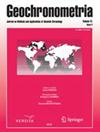Identifying the degree of luminescence signal bleaching in fluvial sediments from the Inner Mongolian reaches of the Yellow River
IF 0.9
4区 地球科学
Q3 Earth and Planetary Sciences
引用次数: 5
Abstract
Abstract The partial bleaching of the luminescence signal prior to deposition results in age overestimation, and can be a problem in delineating fluvial evolution within an OSL chronological framework. The Inner Mongolian reaches of the Yellow River are characterised by a high sediment load and complex sources of sediments. To test the incomplete bleaching occurring in this type of environment, the residual doses and the luminescence signal characteristics of different particle size fractions from 14 modern fluvial sediment samples were investigated. Furthermore, 26 OSL ages derived from drilling cores were compared with 11 radiocarbon ages. Our results show that the residual equivalent doses principally range between 0.16 and 0.49 Gy for silt grains, and between 0.35 and 3.72 Gy for sand grains of modern samples. This suggests that medium-grained quartz has been well bleached prior to deposition, and is preferable to coarse-grained quartz when dating fluvial sediments in this region. The results also show that the De values of coarse-grained fractions display a stronger correlation with distance downstream. In addition, a comparison of OSL and radiocarbon ages from drilling cores establishes further confidence that any initial bleaching of these sediments was sufficient. As a result, we believe that the studied fluvial samples were well bleached prior to deposition.黄河内蒙古河段河流沉积物发光信号漂白程度的识别
摘要沉积前发光信号的部分漂白导致年龄高估,并且可能是在OSL时间框架内描述河流演化的一个问题。黄河内蒙古河段泥沙量大,泥沙来源复杂。为了测试在这种环境中发生的不完全漂白,研究了14个现代河流沉积物样品中不同粒度组分的残留剂量和发光信号特征。此外,将26个钻孔岩芯OSL年龄与11个放射性碳年龄进行了比较。我们的结果表明,现代样品的残余等效剂量主要在0.16至0.49 Gy之间(对于粉粒)和0.35至3.72 Gy之间。这表明中粒石英在沉积前已经被很好地漂白,在该地区的河流沉积物测年时,中粒石英比粗粒石英更可取。结果还表明,粗粒级分的De值与下游距离的相关性更强。此外,对钻孔岩芯的OSL和放射性碳年龄的比较进一步证明了这些沉积物的任何初始漂白都是足够的。因此,我们认为,所研究的河流样品在沉积前经过了很好的漂白。
本文章由计算机程序翻译,如有差异,请以英文原文为准。
求助全文
约1分钟内获得全文
求助全文
来源期刊

Geochronometria
地学-地球科学综合
CiteScore
2.20
自引率
0.00%
发文量
1
审稿时长
>12 weeks
期刊介绍:
Geochronometria is aimed at integrating scientists developing different methods of absolute chronology and using them in different fields of earth and other natural sciences and archaeology. The methods in use are e.g. radiocarbon, stable isotopes, isotopes of natural decay series, optically stimulated luminescence, thermoluminescence, EPR/ESR, dendrochronology, varve chronology. The journal publishes papers that are devoted to developing the dating methods as well as studies concentrating on their applications in geology, palaeoclimatology, palaeobiology, palaeohydrology, geocgraphy and archaeology etc.
 求助内容:
求助内容: 应助结果提醒方式:
应助结果提醒方式:


